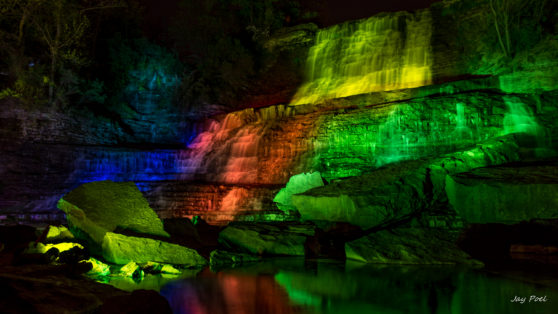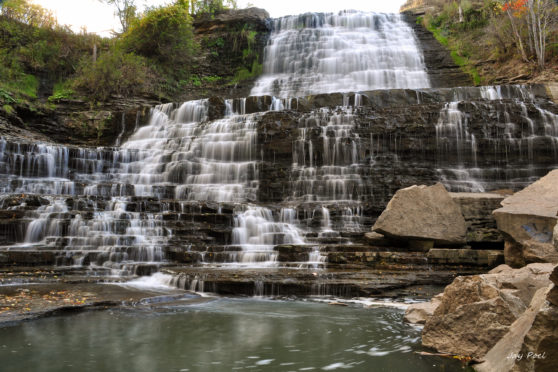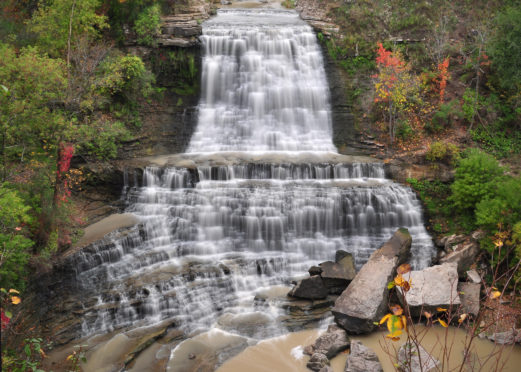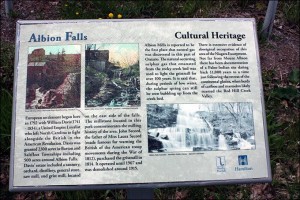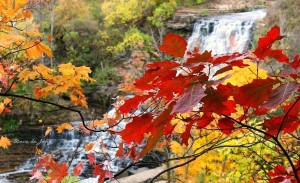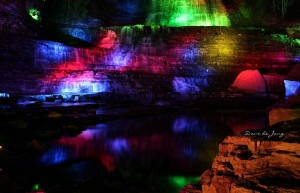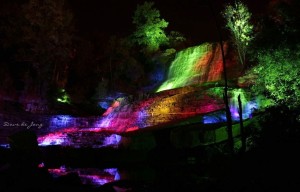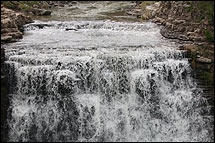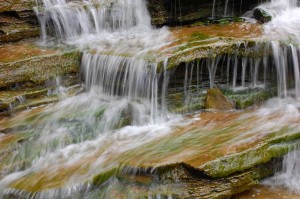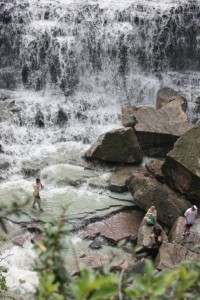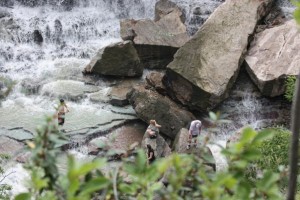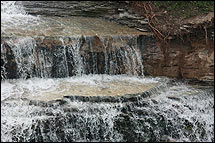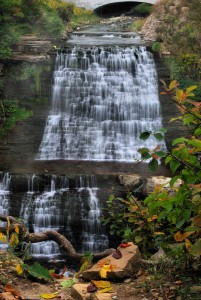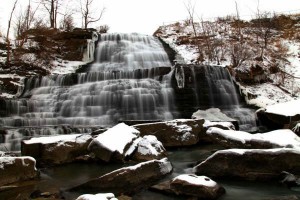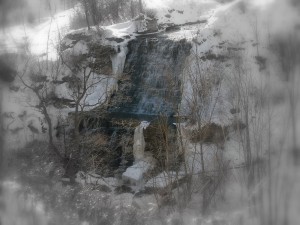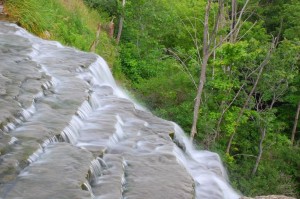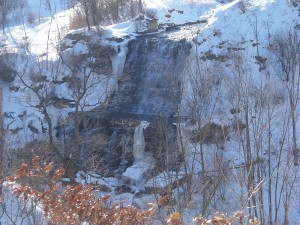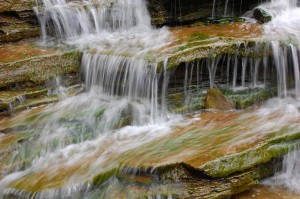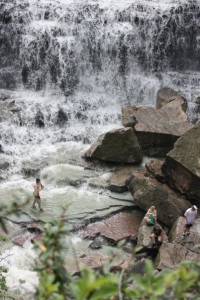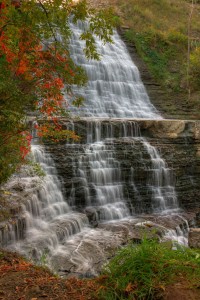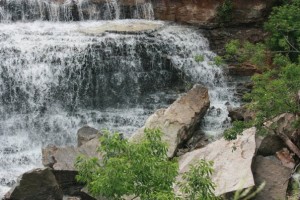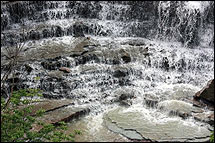*** PLEASE NOTE: CURRENTLY THERE IS NO ACCESS TO THE BOTTOM OF ALBION FALLS ***
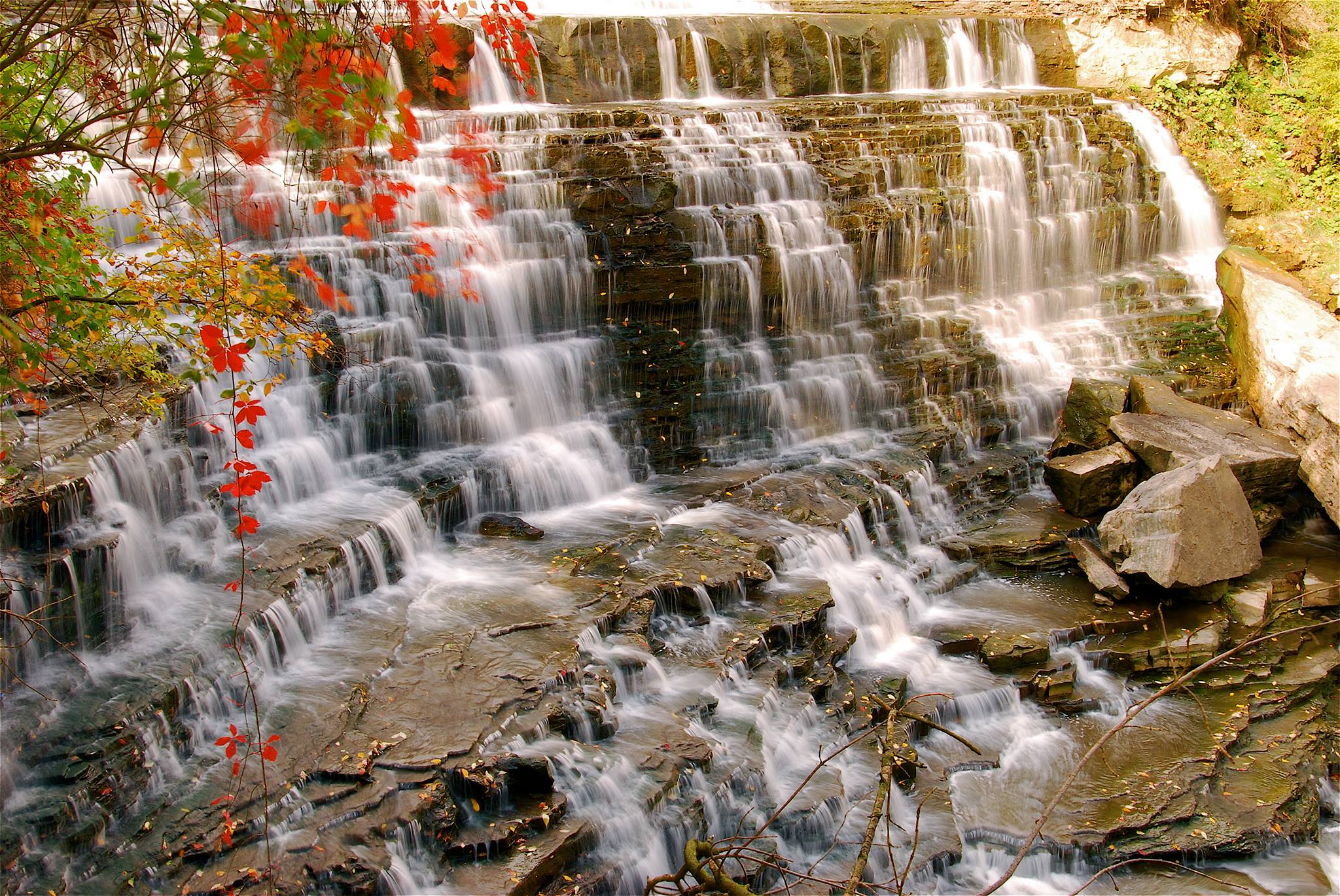
Albion Falls is the premier waterfall in Hamilton’s east end. Two viewing platforms were constructed by the City of Hamilton in 2005 – 2006 at a cost of approximately $350,000. The Project Manager at the City of Hamilton for designing and constructing the two viewing platforms that were built in 2005/2006 was Steve Barnhart, Landscape Architect for the Public Works Department. He also is one of the City of Hamilton representatives on the Hamilton Waterfall Group that meets several times each year.
Rocks from the Albion Falls area were used in the construction of the Royal Botanical Gardens’ Rock Garden.
In July 2009 a weekend rainstorm altered the gorge at Albion Falls. Entire sections were carved out of the earth and the shifting of rocks in the 100 foot wide, forty feet deep space created a third ‘shelf’, making the waterfall more accessible than ever before.
History
This waterfall has a rich history. It was once considered as a possible water supply source for Hamilton, and rocks from the surrounding area were used in the rock garden of the Royal Botanical Garden. The land on which Albion Falls is located was once known as Albion Mills or the Village of Mount Albion.
The original property owner was William Davis, a plantation head who supported the British during the American Revolution. After the British defeat, Davis fled his home in North Carolina in 1792 and came to Canada. After being granted the waterfall and 500 acres of land that surrounded it, Davis established Albion Mills. This small settlement grew into an important community as the nineteenth century progressed, featuring a grist mill, blacksmith shops, taverns, a church and a general store. In 1880, its name was changed to Mount Albion.
The main road through the village was -and still is- called Mud Street. A stone toll road to the city of Hamilton was built in 1880. The keeper collected fifteen cents per return trip for one-horse wagons, and twenty cents for two-horse wagons.
The mill continued to operate until 1907, when Robert Grassie, the owner, fell into the wheel pit and was killed. After that accident, the mill was never run again.
Mount Albion had a strong sulphur spring bubbling up from a shallow drill-hole. According to historian J.E. Turner, who addressed the local historical society in January 1946, “The water does not freeze easily. It is too strong for domestic use, yet is valuable for farm stock.”
Half a mile down the valley, two streams join, one from Buttermilk Falls and another from what was once called the Mill Falls. A dam and a primitive sawmill was located there during the mid-1800s. One day a group of workmen there quarrelled and one of them was killed. His ghost was often seen thereafter, hovering over the stream, travelling along the roads, or flitting through the woods. One tipsy patron of the Black Horse Tavern in Mount Albion was sure that he saw the spirit lurking beside a tree one night. He swung his fist, and discovered to his detriment that the pale form was the dangling corpse of a freshly killed pig. The courageous drunk broke his right arm.
According to Joe Hollick, “In the 1950’s Albion Falls was the destination of hundreds of youngsters (including myself) on Good Friday either walking or biking to Albion Falls or hiking up the Red Hill Creek. During that decade, there was a small general store across the road from Albion Falls and all of us would go in to buy pop and treats after the long trip to Albion Falls. The store was demolished about 1960 and it was a sad day for us youngsters to see the store gone. On these hikes if the volume of water was not too large, we would walk across the ledge half way down the waterfall.”
An 1883 story: My Country Excursion – A Jaunt To The Albion Falls
On Sunday, June 3, 1883, two young men decided to spend the Sabbath out in the countryside surrounding Albion Falls. One of them, writing about his experience for the June 4 edition of the Spectator, admitted, “I guess my friend Tommy and I broke the sanctity of the Sabbath all up yesterday if we are to be judged by the good Calvinistic standard, but I don’t believe the recording angel has made a black mark across his book opposite our names…. Tommy said he felt real good and religious when he stood under the shadow of a big oak tree and listened to the songs of the birds that flitted around us from twig to twig, and heard the plaintive chirp of the ‘Bob White’, gazing the while with a sort of awe at the broad sheet of water as it dashed over the edge of the rock 200 feet above us and fell with a noise like ceaseless thunder upon the table rock at our feet, throwing up a million films of spray, glistening like strings of diamonds in the
sun….”
The two young men met at City Hall at ten o’clock that morning and set out for Albion Mills on foot. They trudged along Main Street East at “a good swinging pace” and veered to the right, toward the mountain, upon reaching the Bartonville tollgate. “Tommy had an idea that the stream we were looking for wound through a ravine just the other side of this projecting rock,” the narrator explained, “and so we trudged along the hard road, uphill, gaining new strength and better spirits all along the way.”
Presently they came to a five-foot tall barred gate that stretched across the road. Whooping with anticipation, they scaled it and approached a nearby farmhouse to ask for a drink of milk. The good-natured farmer obliged. Learning of their destination, he gave them permission to cross his property and thereby take a shortcut to the stream. Careful not to tread on the growing wheat stalks, the boys headed downhill, into a ravine.
“I wanted to see that Albion Mills Creek principally because Tommy had aroused my curiosity by telling me that the water was of such a peculiar nature (that) he could light it with a match and it would burn,” the narrator recalled. “I could hardly believe this, but he had borrowed a few matches from the keeper of the hotel at the Delta, and as we went hopping along from stone to stone, sometimes clinging to an overhead branch to make our chances of getting over the slippery stones more sure… he would stop at for a moment at a place where the stream rushed by over a shallow, and little side currents wandered off through the interstices of the rock, and form little pools eddying around some larger rock which, he obligingly informed me, had been placed there during the glacial period, whatever that was.”
Tommy kept gazing intently into the water as if looking for something. Suddenly he stopped and declared, “Now I’ll show you!” Stooping down, he lit a match and applied it to a small pool whose surface bubbled slightly. “There’s your water on fire!” he shouted gleefully. “Sure enough,” his comrade wrote, “a little jet of flame did leap up from that stream two or three times and then die away in a second. The explanation of the phenomenon was simple enough. Tommy told me that all along the bed of that stream there are little gas wells, and that when we got to the falls I should see more gas coming out of the solid rock than I ever saw burning in a Hamilton gas lamp on a dark, rainy night.”
Although tired by this point, the boys kept going. “We were a long time getting to the falls,” the narrator admitted, “but when I saw the glorious beauty of the spot I felt amply repaid for my long walk. Imagine if you can an immense amphitheater, the slopes of which are covered with verdure and trees just leafing out in all the glory of springtime. One segment of the circle shall be of solid rock towering up 200 feet, and broken once or twice into tables of stone on which the water, rushing over the top, falls, dashes into spray, and gathering new force again, pours down into the bottom of the creek-bed, amid immense boulders that are worn as smooth as ivory by the action of the water. Then the stream goes flashing along through the one opening in the amphitheater’s slopes, through sylvan glades to refresh the weary cattle in the fields below.”
Enthralled by the majestic sight, the young men continued until they came to what the writer described as “a most prosaic flour-mill built right on the edge of the ravine, and a part of the water which should go over the falls is diverted from its course… and made to do plebian duty in turning a turbine wheel to grind flour.”
“Now,” said Tommy, climbing up the steep rock beside the waterfall, “come up here and I’ll show you the place where a jet of gas has been burning for twenty years.” They presently came to a great fissure in the rock, from which a gas pipe ran into the mill. “Oh!” said Tommy somewhat ruefully, “things have changed since I was here last. But come, I’ll show you the gas yet.”
They entered the mill, and found four large gas jets burning brightly, the gas being fed through the pipe in the rock below. While they were gazing at this natural power source in wonder, a roughly dressed man passed them without speaking. They watched him go outside and head down the cliff. “He looked like a plowboy,” the narrator observed, “and after he had gone, and I wondered whether he could have anything to do with the mill, I thought no more about him.”
They left the building after a few more minutes, “went a short distance around the fall and on the road”, and cautiously approached the gorge. They stared down into the roaring, crashing water until they felt themselves become dizzy. Remembering all the local legends about people who fell to their deaths from that vantage point (voluntarily or not), they withdrew and headed back toward the city, flushed from the sun and excitement. Both agreed that the raging beauty of Albion Falls, as well as the infiltration of the mill and the spectacle of the flaming water, had made their Sunday excursion well worth the effort.
-Rose Keefe
www.cityofwaterfalls.ca
Albion Falls Legends
Albion Falls is a place of tremendous beauty, yet it is also the site of numerous tragedies, some famous, some now forgotten. It’s also the location of the first natural gas discovery in Ontario. Read some of the stories below!
Lover’s Leap and other Tragedies
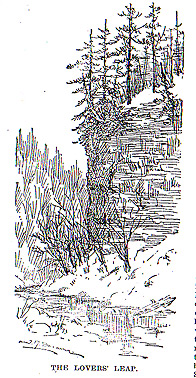
Alas, poor Jane Riley
for Joseph she did die
By jumping off that dizzy brink
full sixty cubits high
Joseph’s mother, who may have been instrumental in the tragic couple’s breakup, apparently said afterward, “Let the blame rest on my shoulders.” Years later, she suddenly screamed, “Jane’s hand is on my shoulder!!” Although in good health up to that point, she collapsed to the floor and died.
Another version of the jilted suicide at the Falls is as follows: a young lady living at Albion Mills fell in love with a farmer who lived nearby. When he failed to return her affection and actually married another girl, she lost the will to live. Soon after the wedding, she walked with a female companion to the precipice of the Falls and, without warning, jumped into the abyss. Some men who witnessed the fall said that her clothing formed a parachute as she hurtled downward and slowed her descent. Not wanting to be saved, she reached down, collapsed the impromptu parachute, and crashed onto the rocks. She survived the fall but died an hour later without regaining consciousness.
However it actually happened, Lover’s Leap was further marred by tragedy during the 1940s, when a truck left the road and plunged into the valley below, killing a young girl. Infamous murderess Evelyn Dick also dumped the headless remains of her husband, John, in the area in March 1946.
How to get there
If you are coming from the west by car and are travelling on the Lincoln Alexander Parkway exit on Dartnell Road from the Lincoln Alexander Parkway. As soon as you take the exit, get over to the left lane and turn left at the light onto Stonechurch Road East. After about 1 km you will see Leons on your left hand side, you want to turn left onto Pritchard Road, and travel to the stop sign. Then turn left again onto Mud Street. in a few hundred feet you will see a hairpin turn, you can turn left onto Arbour road and park there, or travel up further and park in the upper parking lot and take advantage of the two viewing platforms there. If you have children, or do not want to walk much I suggest you use the upper lot and view albion falls from the two platforms.
Directions to Get there Via Google Maps:
To reach Albion Falls via a walking trail, take the Escarpment Rail Trail or the Albion Side Trail of the Bruce Trail.
Albion Falls Video Gallery
Video Credit Shawn Legg
Video Credit Dan Copeland – http://dancopeland.ca/dcphotography/
Albion Falls Photo Gallery
